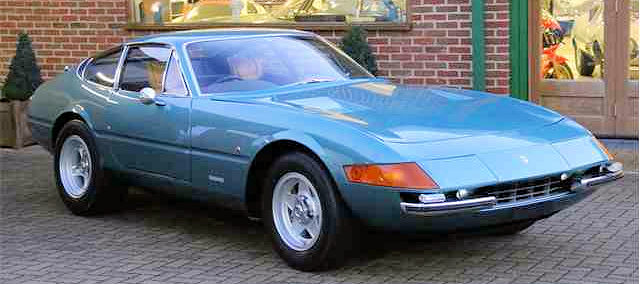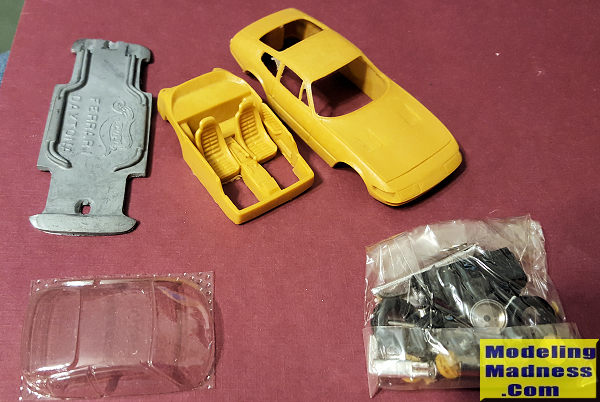
| KIT #: | 49 |
| PRICE: | $21.00 (second hand) |
| DECALS: | None |
| REVIEWER: | Scott Van Aken |
| NOTES: | Resin multimedia kit |

| HISTORY |
The Ferrari Daytona, officially designated the Ferrari 365 GTB/4, is a two-seat grand tourer produced by Ferrari from 1968 to 1973. It was introduced at the Paris Auto Salon in 1968 to replace the 275 GTB/4, and featured the 275's Colombo V12 bored out to 4.4 L (4,390.35 cc, 267.9 cid).
The Daytona was succeeded by the mid-engined 365 GT4 Berlinetta Boxer in 1973.
The unofficial Daytona name is reported to have been applied by the media rather than Ferrari and commemorates Ferrari's 1-2-3 finish in the February 1967 24 Hours of Daytona with a 330 P3/4, a 330 P4 and a 412 P. To this day, Ferrari itself only rarely refers to the 365 as the "Daytona", and refer to it as an "unofficial" name.
Unlike Lamborghini's then-new, mid-engined Miura, the Daytona was a traditional front-engined, rear-drive car.
The engine, known as the Tipo 251 and developed from the earlier Colombo V12 used in the 275 GTB/4, was a 4.4 L (4,390.35 cc, 267.9 cid) DOHC V12 with a 60° bank angle, 365 cc per cylinder, 81 mm (3.2 in) bore and 71 mm (2.8 in) stroke, featuring six Weber twin carburettors (40 mm Solex twin carburettors were used alternatively). At a compression ratio of 9.3:1, it produced 357 PS (263 kW; 352 hp) and could reach 280 km/h (174 mph). 0-60 mph (97 km/h) acceleration was just 5.4 seconds. For the American version, slight modifications were made - the compression ratio was reduced to 8.8:1 and the exhaust system was equipped with a large central silencer, necessitating visible alterations to the primary pipes.
The five-speed manual transmission (of the transaxle concept) was mounted in the rear for optimal weight distribution, and a four-wheel independent suspension featured wishbones and coil springs.
Although a Pininfarina design, as with many previous Ferrari road cars styled by Leonardo Fioravanti, the 365 GTB/4 was radically different. Its sharp-edged styling resembled a Lamborghini more than a traditional Pininfarina Ferrari.
Early Daytonas featured fixed headlights behind an acrylic glass cover. A new U.S. safety regulation banning headlights behind covers resulted in retractable pop-up twin headlights in 1971.
| THE KIT |
A s
Yet another French 1/43 multimedia car kit. This time, it is by Record. As you can see, the major parts of the car, interior and body are in resin. The molding is excellent with no visible flaws. There are, on the underside of these pieces, some pretty hefty pour stubs and there is some flash, but overall, they are very well done. Interestingly, this one has a metal chassis pan with the exhaust molded into it.
The bag contains all the various smaller bits and since the cellophane is still in good shape, I have left it closed in order to not lose any smaller bit. The chrome pieces are in there as is the steering wheel, axles, aluminum wheels, wheel inserts, tires, mirrors and other smaller bits. There is a single clear vacuformed piece for the windows. Also in the bag I seem to recall seeing some p.e. windscreen wipers. These are two pieces each and look like a bit of a pain to install.
There are no instructions. As I mentioned earlier, I bought four of these kits and none come with assembly instructions. No painting guide or photo either, but thankfully, Ferraris are well represented on the Internet and a lot of images are there for guidance.
| CONCLUSIONS |
| REFERENCES |
https://en.wikipedia.org/wiki/Ferrari_Daytona
June 2017
Copyright ModelingMadness.com. All rights reserved.
If you would like your product reviewed fairly and fairly quickly, please contact the editor or see other details in the Note to Contributors.
Back to the Main Page Back to the Review Index Page Back to the Previews Index Page